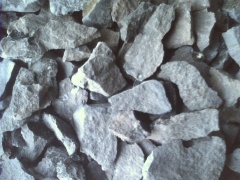Difference between revisions of "Calcium Carbide"
(Created page with "==Description== Greyish-black irregular hard lumps or powder. Shipped in water-tight and air-tight metal containers. If containers burst due to rough handling, the contents will...") |
(→Application) |
||
| (19 intermediate revisions by 3 users not shown) | |||
| Line 1: | Line 1: | ||
| + | {{Infobox_Machinery | ||
| + | | image = Calcium_Carbide-1.jpg | ||
| + | | origin = - | ||
| + | | stowage factor = 1,13 m<sup>3</sup>/ft (drums) | ||
| + | | humidity and moisture = - | ||
| + | | ventilation = - | ||
| + | | risk factors = See text | ||
| + | }} | ||
| + | __TOC__ | ||
==Description== | ==Description== | ||
| − | + | Calcium carbide is a chemical compound with the chemical formula of CaC2. Its main use industrially is in the production of acetylene and calcium cyanamide.<br><br> | |
| + | Calcium carbide is produced industrially in an electric arc furnace from a mixture of lime and coke at approximately 2000°C.<br><br> | ||
| + | The high temperature required for this reaction is not practically achievable by traditional combustion, so the reaction is performed in an electric arc furnace with [[graphite]] electrodes. The carbide product produced generally contains around 80% calcium carbide by weight. The carbide is crushed to produce small lumps that can range from a few mm up to 50 mm. The impurities are concentrated in the finer fractions. The CaC2 content of the product is assayed by measuring the amount of acetylene produced on hydrolysis.<br><br> | ||
| + | The pure material is colorless, however pieces of technical-grade calcium carbide are grey or brown and consist of only 80-85% of CaC2 (the rest is CaO (calcium oxide), Ca3P2 (calcium phosphide), CaS (calcium sulfide), Ca3N2 (calcium nitride), SiC (silicon carbide), etc.). Because of presence of PH3 (phosphine), NH3 (ammonia), and H2S (hydrogen sulfide), technical-grade calcium carbide has a distinctive smell ([[garlic]] like odour) which some find unpleasant.<br><br> | ||
| + | ==Application== | ||
| + | Generation of acetylene gas for welding, chloroethylenes, vinyl acetate monomer, acetylene chemicals, reducing agent.<br><br> | ||
| − | + | Calcium carbide is also used:<br><br> | |
| + | * In the desulfurisation of iron ([[Pig Iron]], cast iron and steel) | ||
| + | * As a fuel in steelmaking to extend the scrap ratio to liquid iron, depending on economics. | ||
| + | * As a powerful deoxidizer at ladle treatment facilities.<br><br> | ||
| − | a | + | ==Shipment storage== |
| − | + | Flammable materials should be stored in a separate safety storage cabinet or room. Keep away from heat. Keep away from sources of ignition. Keep container tightly closed. Keep in a cool, well-ventilated place. Ground all equipment containing material. Keep container dry. Keep in a cool place.<br><br> | |
| − | + | ==Risk Factors== | |
| + | Causes severe eye irritation and possible eye injury. May cause skin and respiratory tract irritation. Hygroscopic (absorbs moisture from the air).<br><br> | ||
| + | See also MSDS sheet(s).<br><br> | ||
| + | Reference is also made to the relevant IMO regulations on hazardous cargo.<br><br> | ||
| − | |||
[[Category:Products]] | [[Category:Products]] | ||
| + | [[Category:Oil and chemicals]] | ||
Latest revision as of 10:56, 31 October 2012
| Infobox on Calcium Carbide | |
|---|---|
| Example of Calcium Carbide |  |
| Facts | |
| Origin | - |
| Stowage factor (in m3/t) | 1,13 m3/ft (drums) |
| Humidity / moisture | - |
| Ventilation | - |
| Risk factors | See text |
Calcium Carbide
Description
Calcium carbide is a chemical compound with the chemical formula of CaC2. Its main use industrially is in the production of acetylene and calcium cyanamide.
Calcium carbide is produced industrially in an electric arc furnace from a mixture of lime and coke at approximately 2000°C.
The high temperature required for this reaction is not practically achievable by traditional combustion, so the reaction is performed in an electric arc furnace with graphite electrodes. The carbide product produced generally contains around 80% calcium carbide by weight. The carbide is crushed to produce small lumps that can range from a few mm up to 50 mm. The impurities are concentrated in the finer fractions. The CaC2 content of the product is assayed by measuring the amount of acetylene produced on hydrolysis.
The pure material is colorless, however pieces of technical-grade calcium carbide are grey or brown and consist of only 80-85% of CaC2 (the rest is CaO (calcium oxide), Ca3P2 (calcium phosphide), CaS (calcium sulfide), Ca3N2 (calcium nitride), SiC (silicon carbide), etc.). Because of presence of PH3 (phosphine), NH3 (ammonia), and H2S (hydrogen sulfide), technical-grade calcium carbide has a distinctive smell (garlic like odour) which some find unpleasant.
Application
Generation of acetylene gas for welding, chloroethylenes, vinyl acetate monomer, acetylene chemicals, reducing agent.
Calcium carbide is also used:
- In the desulfurisation of iron (Pig Iron, cast iron and steel)
- As a fuel in steelmaking to extend the scrap ratio to liquid iron, depending on economics.
- As a powerful deoxidizer at ladle treatment facilities.
Shipment storage
Flammable materials should be stored in a separate safety storage cabinet or room. Keep away from heat. Keep away from sources of ignition. Keep container tightly closed. Keep in a cool, well-ventilated place. Ground all equipment containing material. Keep container dry. Keep in a cool place.
Risk Factors
Causes severe eye irritation and possible eye injury. May cause skin and respiratory tract irritation. Hygroscopic (absorbs moisture from the air).
See also MSDS sheet(s).
Reference is also made to the relevant IMO regulations on hazardous cargo.











